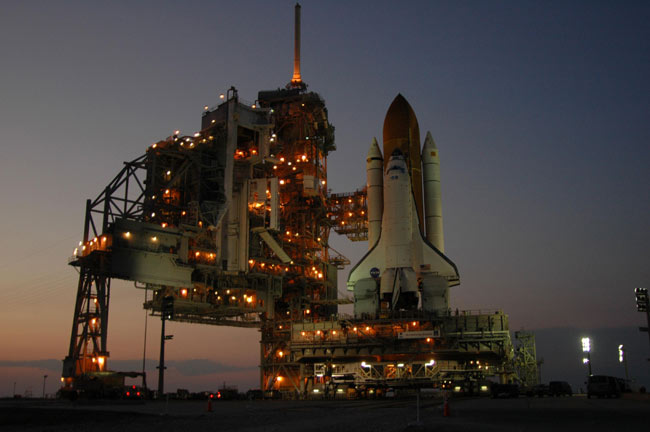STS-121 at the Pad: NASA's Discovery Shuttle Reaches Launch Site

This storywas updated at 9:30 p.m. EDT.
CAPE CANAVERAL, Fla. – The space shuttle Discovery isback at the launch pad as workers prepare the spaceplane for NASA’ssecond orbiter mission since the 2003 Columbia accident.
A massive crawler carrier hauled Discovery and its mobilelaunch platform up to Pad 39B at the Kennedy Space Center (KSC) here more thanseven hours after leaving the shelter of NASA’s Vehicle Assembly Building(VAB) at about 12:45 p.m. EDT (1645 GMT).
“It’s a fabulous feeling to see that we’rerolling Discovery back to the launch pad for our next launch attempt,”NASA’s shuttle program manager Wayne Hale told reporters after ridingwith the orbiter as it left the VAB. “I think we’re on a reallygood path to make that July 1 window opening day.”
The orbiter's move marked a major milestone for NASA's STS-121mission – the agency's second shuttle test flight since the 2003 Columbia accident.Discovery is currently slated to launch its astronaut crew, commanded byshuttle veteran StevenLindsey, on a mission to test shuttle fuel tank modifications, orbiterrepair techniques and resupply the International Space Station (ISS) betweenJuly 1 and July 19.
Hale said that preliminary results of wind tunnel tests tocheck changes to Discovery’s external fuel tank – primarily the removalof a foam ramp that guarded pressure lines – are positive, butwon’t be final for about three weeks. While wind tunnel tests haveconcluded, a detailed analysis of their data is still underway, he added.
“We have to wait until we get to the bottom line,”Hale said. “We could be smarter tomorrow and somebody could find outsomething we need to deal with.”
Get the Space.com Newsletter
Breaking space news, the latest updates on rocket launches, skywatching events and more!
Today’s rollout allowed Discovery to join its payload– a cargo pod dubbed Leonardo, spare space station parts and other items– at Pad 39B. The Leonardo module and equipment palettes will be loadedinto Discovery’s cargo bay after engineers shroud the spacecraft with itsprotective Rotating Service Structure, an activity currently slated to occurSunday, NASA officials said.
Meanwhile, Hale said he is confident that Discovery’splanned July launch will be the first of three shuttle flights this year.Additional launch opportunities arise on Aug. 28 and Dec. 14, he added.
“Now it will be tight…it depends a lot on thetank,” Hale said of the third shuttle flight’s external tank– External Tank 123 – which engineers are working to complete earlyto support a possible rescue flight should anything go awry during the plannedAugust space shot. “Given that, we have a good shot at making threeshuttle flights this year.”
Preparing Discovery
Engineers at KSC spent the last week mating Discovery to the externaltank and solid rocket boosters – known as the launch stack – thatwill push the 100-ton spaceplane into orbit. During that time, shuttle workersalso took detailed photographs of the orbiter's heat shield to be compared toimages from in-orbit inspections during the STS-121 mission, integrationengineers told SPACE.com,adding that they took similar photos while preparing Discovery for NASA's firstpost-Columbia mission STS-114.
"Everyone was excited for STS-114 and they're doubly sofor STS-121 because it's our opportunity to get into regular launch modeagain," said Tim Riley, the shuttle's integrated operations chief for NASAcontractor United Space Alliance, in a recent interview. "Hopefully, we'llget a couple more [shuttle flights] in this year.
Discovery's STS-121 mission is the last of two post-Columbiaaccident test flights to shakedown new shuttle safety and repair methods beforeNASA can resumeconstruction of the ISS later this year. While NASA is currently targetingJuly 1 to launch Discovery's STS-121 mission, the orbiter has a flightwindow that extends through July 19. Additional shuttle launch opportunitiesopen in late August and mid-December.
NASA's 5.5 million-pound (2.5 million-kilogram) crawlervehicles have transported NASA spacecraft to and from their launch pads sincethey first became operations in 1966. The entire assembly – includingDiscovery, its fuel tank and boosters, mobile launch platform and crawlervehicle – weight about 17.5 million pounds (7.9 million kilograms) andmove at a top speed of about one mile per hour (1.6 kilometers per hour).
“It was great,” said Hale, who rode the immensecrawler as hefted Discovery toward the launch pad. “It’s betterthan going on a cruise ship.”
- STS-121 Astronauts Train Hard for Shuttle Launch
- NASA Forgoes Fuel Tank Test for Next Shuttle Launch
- NASA's Next Shuttle to Fly Without Ice Frost Ramp Fix
- Return to Flight: NASA's Road to STS-121
Join our Space Forums to keep talking space on the latest missions, night sky and more! And if you have a news tip, correction or comment, let us know at: community@space.com.

Tariq is the Editor-in-Chief of Space.com and joined the team in 2001, first as an intern and staff writer, and later as an editor. He covers human spaceflight, exploration and space science, as well as skywatching and entertainment. He became Space.com's Managing Editor in 2009 and Editor-in-Chief in 2019. Before joining Space.com, Tariq was a staff reporter for The Los Angeles Times covering education and city beats in La Habra, Fullerton and Huntington Beach. In October 2022, Tariq received the Harry Kolcum Award for excellence in space reporting from the National Space Club Florida Committee. He is also an Eagle Scout (yes, he has the Space Exploration merit badge) and went to Space Camp four times as a kid and a fifth time as an adult. He has journalism degrees from the University of Southern California and New York University. You can find Tariq at Space.com and as the co-host to the This Week In Space podcast with space historian Rod Pyle on the TWiT network. To see his latest project, you can follow Tariq on Twitter @tariqjmalik.









